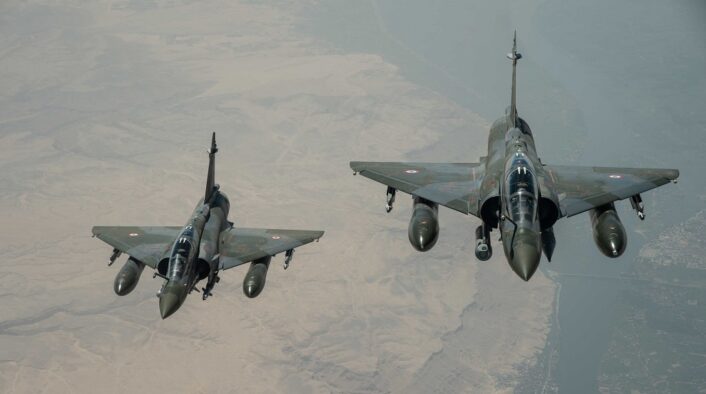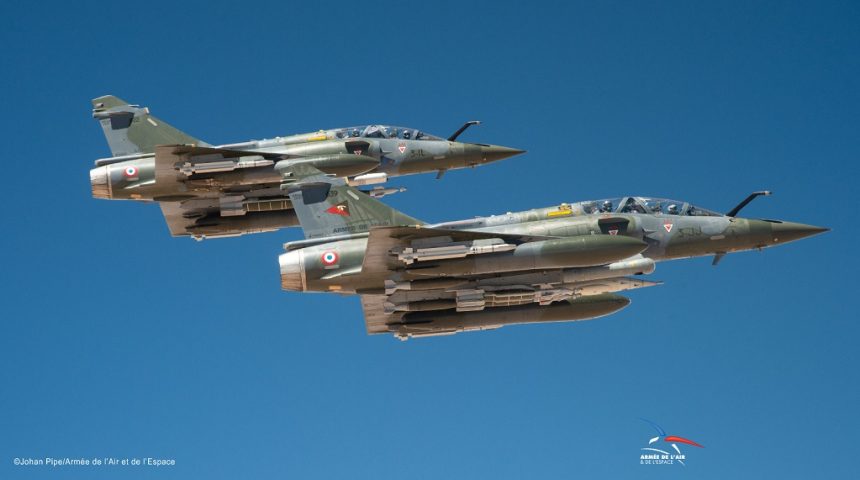The 20-day-long campaign allowed to validate the French Mirage 2000’s Mid-Life Upgrade and the new podded cannon in realistic conditions.
The Armée de l’Air et de l’Espace (French Air and Space Force) recently completed a test campaign in Djibouti for the Mirage 2000D in the new RMV (Rénovation Mi-Vie/Mid-Life Upgrade) standard. Two aircraft upgraded to the new standard were deployed from July 1 through 20 at the Base Aérienne (Air Base) 188 Djibouti with the Escadron de Chasse et d’Expérimentation (Fighter and Experimental Squadron) 1/30 “Côte d’Argent”.
The goal of this deployment was to test the Mirage 2000D RMV in realistic combat conditions in hot weather, as well as testing the new CC422 cannon pod in the same conditions. During their stay, the upgraded aircraft carried out various missions in coordination with the Mirage 2000-5 of the Escadron de Chasse 3/11 “Corsica” and Forward Air Controllers (FAC), testing in demanding climatic conditions the entire “ecosystem” of the aircraft, including support equipment, mission planning and debriefing systems and so on.
The Mirage 2000D RMV project was first announced in 2016, with the goal of allowing the aircraft to be able to operate in conjunction with the newer Rafale well after 2030. The French Air Force is expected to receive 55 upgraded aircraft (the first was delivered in January), with a planned Initial Operational Capability in Spring 2022. In addition to the more modern avionics, this upgrade includes a gun pod (as the Mirage 2000D is not equipped with an internal gun), new weapons and sensors.
The CC422 gun pod contains a DEFA 550 F3 30mm cannon, with a reportedly 250 rounds magazine, and is derived from the CC420 pod carried by the Mirage F1Bs. The new pod, which is shorter than the original Mirage F1 gun pod, is installed on the left chin pylon below the air intake. The CC422 was tested for the first time in 2018 on the ground, with inflight testing started a year later and successfully completed in 2020. A cannon that could be used during Close Air Support missions was a long-sought capability for the Mirage 2000D, as it lacks the internal gun as opposed to its single seater counterpart, the Mirage 2000-5 and 2000C.

As for the weapons, the Mirage 2000D RMV replaced the Magic II with the newer Mica IR for self-defense, while the GBU-48 and GBU-50 Enhanced Paveway II dual mode GPS/Laser-guided bombs now join the already operational GBU-49 and the laser-guided bombs from the Paveway II and III series, as well as the SCALP cruise missile. As for the sensors, the Mirage 2000D RMV will rely on the Damocles pod for target designation, as well as the ASTAC (Analyseur de signaux tactiques) ESM/ELINT (Electronic Support Measures/ELectronic INTelligence) pod already used by the Mirage F1.
Regarding the avionics, the Mirage 2000D RMV is reported to be equipped with new VHF radios, Link 16 datalink and ROVER video system to better support CAS missions. A new navigation and attack system has been installed as well, with a new interface which should facilitate the dialogue between the crew and the machine. Integrated simulation systems will allow for increased training capabilities while inflight. An interesting detail noticed in the photos is what seems to be the Scorpion Helmet Mounted Display, the same HMD system that was chosen also for the Rafale.
The Mirage 2000D first entered service in 1993 as a dedicated air-to-ground attack platform and took part in every French mission abroad since then. The 2013 White Paper on Defense and National Security calls for a total of 225 aircraft for the French Air Force, which prompted the need to extend the operational life of the Mirage 2000D. After some setbacks because of budget cuts, the RMV program was finally launched for 71 Mirage 2000Ds, which were later reduced to 55 before the contract for the upgrade work was awarded to Dassault.








